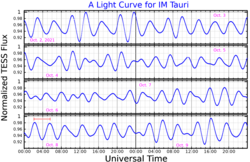| Observation data Epoch J2000.0 Equinox J2000.0 | |
|---|---|
| Constellation | Taurus |
| Right ascension | 04h 10m 49.86084s [3] |
| Declination | +26° 28′ 51.4365″ [3] |
| Apparent magnitude (V) | 5.37 - 5.58 [4] |
| Characteristics | |
| Spectral type | F2 IV [5] |
| Variable type | δ Scuti [4] |
| Astrometry | |
| Radial velocity (Rv) | 17.43±0.64 [3] km/s |
| Proper motion (μ) | RA: −30.919±0.123 [3] mas/yr Dec.: −35.105±0.072 [3] mas/yr |
| Parallax (π) | 15.4199±0.0863 mas [3] |
| Distance | 212 ± 1 ly (64.9 ± 0.4 pc) |
| Absolute magnitude (MV) | 1.44±0.16 [6] |
| Details | |
| Primary | |
| Mass | 1.89 [6] M☉ |
| Surface gravity (log g) | 3.6±0.1 [5] cgs |
| Temperature | 7000±200 [7] K |
| Rotational velocity (v sin i) | 2±1 [7] km/s |
| Other designations | |
| p Tauri, IM Tauri, BD+26 411, HIP 19513, HD 26322, HR 1287, SAO 76485 [8] | |
| Database references | |
| SIMBAD | data |
44 Tauri, also known as HD 1287 and IM Tauri, is a star located about 210 light years from the Earth, in the constellation Taurus. [3] It is a 5th magnitude star, making it faintly visible to the naked eye of an observer located far from city lights. It is a Delta Scuti variable star, ranging between magnitude 5.37 and 5.58 over a period of about 3.5 hours. [4]
In 1966, Ivan Danziger and Robert Dickens discovered that 44 Tauri was a low amplitude variable star, with a period of approximately 3.22 hours. [9] In a follow-up study published the next year, they reported that the period was irregular, indicating beat phenomena, and they classified it as a δ Scuti variable. [10] In 1968, 44 Tauri was given the variable star designation IM Tauri. [11]
44 Tauri has been a popular object for detailed astroseismic and spectroscopic studies, because its very slow (relative to other δ Scuti stars) rotation speed of 3±2 km/sec does not complicate pulsation mode identification or greatly broaden spectral lines. [5] [7] [12] As of 2010, 44 Tauri had been found to pulsate with 15 independent periods, ranging from 1.89 to 4.52 hours. [5]
